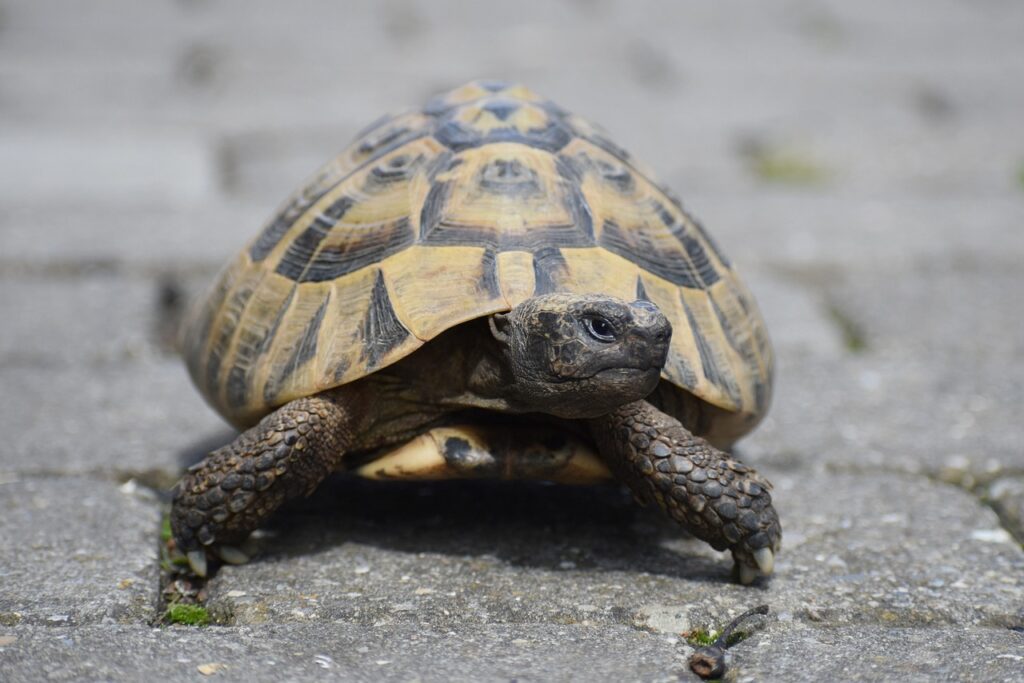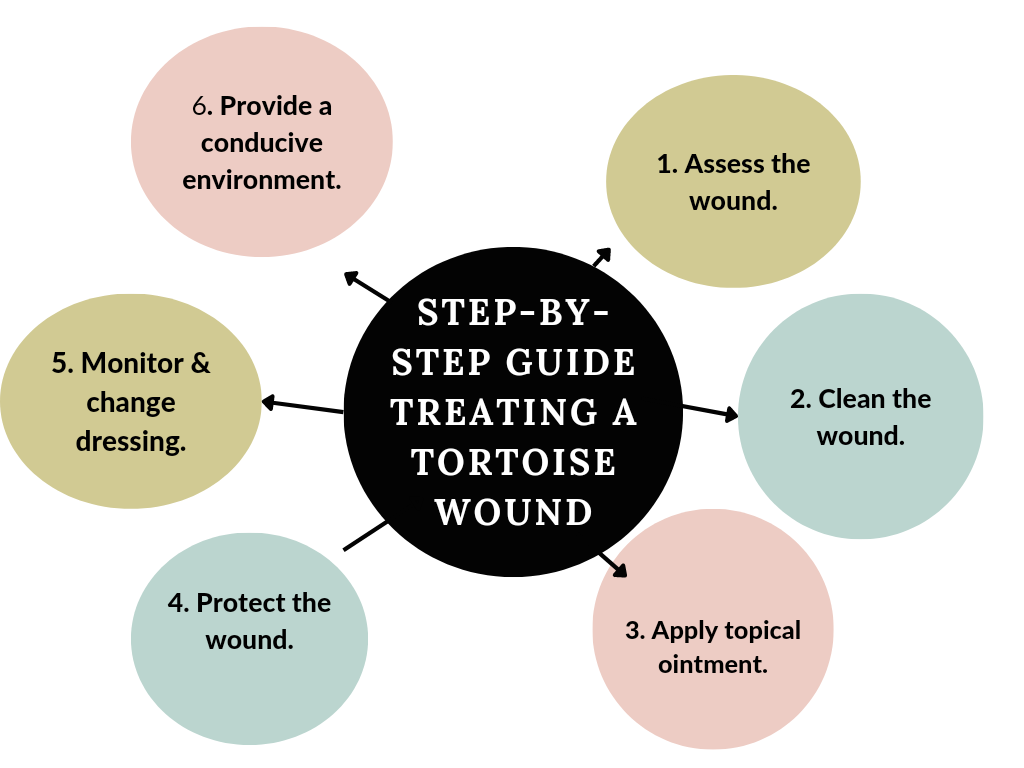
Image: Tortoise Pixabay
Treating a tortoise wound? To keep them safe, quick attention is key! Clean the wound gently with warm water and mild soap. Harsh chemicals are a no-go! Betadine and a cotton ball can prevent infection. But, apply lightly to avoid discomfort for your pet.
If there’s redness, swelling, or pus, get a vet’s help right away. They’ll know what medicines, like antibiotics, to give.
Keep watch on your beloved tortoise as they heal. Complications? Seek assistance quickly to ensure their well-being.
Remember, treating a tortoise wound in time is crucial. Follow these steps, and you’ll have a healthy, happy reptile in no time!
Key Takeaways
- Promptly clean the wound: It is crucial to clean a tortoise wound as soon as possible to prevent infection. Use a mild antiseptic solution and gently wash the area, being careful not to cause further damage.
- Apply an antibiotic ointment: After cleaning the wound, apply a thin layer of antibiotic ointment to help prevent infection. This will create a barrier against bacteria and promote healing.
- Keep the wound covered: To protect the wound from further injury and contamination, cover it with a clean, non-stick dressing. This will also help to keep the area moist, which aids in the healing process.
- Monitor for signs of infection: Keep a close eye on the wound for any signs of infection, such as redness, swelling, discharge, or a foul odor. If any of these symptoms occur, seek veterinary attention immediately.
- Provide a clean and comfortable environment: Ensure that the tortoise’s enclosure is clean and free from any potential hazards that could further injure the wound. Maintain proper temperature and humidity levels to promote healing.
- Limit activity and handle with care: Restrict the tortoise’s movement and avoid handling it excessively while the wound is healing. This will minimize the risk of reopening the wound or causing additional stress to the tortoise.
- Consult a veterinarian: If the wound is severe, deep, or does not show signs of improvement within a few days, it is best to consult a veterinarian. They can provide professional advice and may need to administer additional treatments or prescribe antibiotics.
- Remember, treating a tortoise wound requires patience and diligence. By following these key takeaways, you can help ensure a successful recovery for your tortoise.
Understanding Tortoise Wounds
Caring for a hurt tortoise? Give it the best care with these tips!
- Cleanse the wound with warm saline solution.
- Apply antiseptic ointment.
- Protect it from further injury.
- Monitor the wound.
- Seek professional help if needed.
With patience and proper care, you can ensure your tortoise’s long-term wellbeing.
Gathering Supplies for Treating a Tortoise Wound
For treating a tortoise wound, having the right supplies is essential. Here are five must-haves:
- Antiseptic Solution or Wound Cleanser: To clean the wound and prevent infection. Dilute with water and apply with a cotton ball.
- Sterile Gauze or Non-stick Pads: To cover the wound after cleaning. Secure with medical tape.
- Antibiotic Ointment: A small amount to promote healing and prevent infection. Check ingredients for safety.
- Sterile Disposable Gloves: To protect from contamination and cross-infection.
- Tweezers or Forceps: Sterilize before using to remove debris from wound gently.
Remember to keep your hands clean, don’t touch or poke the wound, and keep your tortoise calm. Prompt care will help prevent complications and ensure proper healing. If in doubt, consult a vet with reptile experience. Waiting for your ex to apologize? It’s slower than a tortoise healing its wound!
Step-by-Step Guide on Treating a Tortoise Wound

A tortoise wound can be treated with a step-by-step approach to ensure proper healing and minimize the risk of infection. Here’s a concise guide on how to treat a tortoise wound:
- Assess the wound: Carefully examine the tortoise’s wound to determine its severity and whether professional veterinary intervention is required. Look for signs of infection, such as redness, swelling, or discharge.
- Clean the wound: Use a mild antiseptic solution recommended by your veterinarian to clean the wound. Gently remove any dirt or debris, being cautious not to cause further injury to the tortoise.
- Apply topical ointment: After cleaning, apply an appropriate topical ointment or wound care product as advised by your veterinarian. This can help prevent infection and promote healing.
- Protect the wound: Depending on the location and severity of the wound, it may be necessary to protect it from further damage. This can be done by placing a clean, non-adhesive dressing or bandage over the wound, ensuring it is not too tight.
- Monitor and change dressings: Regularly inspect the wound for any signs of infection or worsening condition. Change dressings as recommended by your veterinarian to maintain cleanliness and facilitate healing.
- Provide a conducive environment: Ensure the tortoise’s enclosure is clean and well-maintained to promote a healthy healing environment. Monitor the tortoise’s behavior and appetite, as any changes may indicate a complication that requires attention.
Remember, each tortoise’s wound may vary, and it’s crucial to consult with a veterinarian experienced in reptile care. Following these steps can aid in the healing process and help your tortoise recover from its wound without further complications.
In addition to the step-by-step guide, it’s essential to note that tortoises have a relatively slow healing process due to their metabolic rate. Therefore, regular monitoring and patience are crucial throughout the recovery period.
As a testament to the importance of proper wound care for tortoises, let me share a true story. A tortoise named Sheldon had sustained a deep cut on his leg. His owner promptly sought veterinary care and followed the prescribed treatment plan, including diligent wound cleaning and dressings. With time and care, Sheldon’s wound gradually healed, allowing him to return to his usual activities, highlighting the importance of prompt treatment and consistent wound care for tortoises.
When it comes to assessing a tortoise wound, just remember that the shell is not a superhero costume and can’t hide everything.
Assessing the Wound
Take close note of a tortoise’s wound: size, depth, and location. Use a lighted area to evaluate. Look for signs of infection – redness, swelling, and discharge – and take care of them right away. Check for any foreign objects or debris that may be embedded.
Then, observe the tortoise’s behavior and overall health. Any changes or abnormalities may influence treatment. If in doubt, consult a reptile specialist.
Remember, each tortoise may react differently to wounds due to individual characteristics and species-specific traits. Handle with gentle care to avoid additional stress. Cleaning the wound is like scrubbing away all the tortoise’s regrets!
Cleaning the Wound
Clean a tortoise wound with caution! It’s important to properly clean the wound to prevent infections and promote healing. Here’s the step-by-step guide:
- Assess the wound: Carefully examine the wound. Look for signs of infection like redness, swelling, or discharge to determine the severity.
- Gather supplies: Get all the necessary supplies, such as clean gauze pads, antiseptic solution, and sterile saline solution.
- Clean carefully: Wipe around the wound with a sterile saline solution or mild antiseptic solution. This helps remove dirt and debris without causing harm.
- Apply antiseptic solution: Cover all exposed flesh with an antiseptic solution using a clean gauze pad or cotton ball.
Here are some extra tips:
- Handle with care: Handle your tortoise gently and calmly. They can be sensitive creatures.
- Seek veterinary assistance: If the wound worsens or your tortoise seems distressed, get advice from a vet.
Cleaning a tortoise wound with care will help ensure a successful and speedy recovery!
Applying Antiseptic Solution
Caring for a tortoise wound? Applying an antiseptic solution is key! It helps stop infection and helps the wound heal. Here’s a guide on how to do it right:
- Clean the wound gently. Use a clean cloth or gauze pad soaked in warm water. Get rid of any dirt or debris that may be there.
- Dilute the antiseptic solution. Read the instructions on the bottle and dilute it with water – this way it won’t be too strong and harm the tortoise’s skin.
- Apply the solution. Use a cotton swab or sterile applicator to apply the diluted antiseptic solution to the wound. Cover all areas of the wound.
- Let air dry. After you’ve applied the solution, let it air dry naturally. Don’t cover the wound with bandages or dressings – unless your vet says so.
- Repeat as needed. Depending on the seriousness of the wound, you may need to do this daily. Keep monitoring and re-applying the antiseptic solution to help healing and avoid problems.
Remember to use an antiseptic solution suitable for tortoises. And if you spot any signs of infection or the wound getting worse, get in touch with a vet.
Give your tortoise the care they deserve! Take action now and don’t wait until it’s too late. Make them look fashionable while healing – bandage one shell at a time!
Bandaging the Wound
Back in 2016, there was a heartwarming story. It was about a tortoise called Rocky. Rocky had a severe injury from an altercation with another tortoise. His owner sought help from a vet. They made sure to follow the wound care procedures. This led to Rocky’s recovery in several weeks.
This is why it is important to care for a tortoise’s wound. Here is a step-by-step guide to help you out:
| Step | Instructions |
|---|---|
| 1 | Clean the wound. Use mild saline solution or warm water. This removes any bacteria that would stop healing. |
| 2 | Use an antiseptic made for reptiles. This prevents infection and helps the wound recover faster. |
| 3 | Put a sterile non-stick pad over the wound. Make sure it covers the entire area. Secure it with gauze or adhesive tape. Don’t wrap it too tightly. |
Remember, you should ask a vet for advice suited to your situation. Taking care of a tortoise’s wound needs caution and precision!
Monitoring the Healing Process
Monitoring the Healing Process plays a crucial role in assessing the progress of a tortoise’s wound. Regular monitoring helps ensure appropriate treatment and timely intervention if needed. Here are the key points for effectively monitoring the healing process:
- Visual Examination: Carefully observe the wound for any changes in appearance, such as size, color, or discharge.
- Wound Size Measurement: Keep track of the wound dimensions using a measuring tool to evaluate any reduction in size over time.
- Swelling Evaluation: Monitor the surrounding area of the wound for any signs of inflammation or swelling.
- Sensitive Touch: Gently touch the area around the wound to check for any pain or discomfort experienced by the tortoise.
- Behavior Observation: Pay attention to the tortoise’s behavior, looking for signs of distress or abnormal activity that may indicate a problem with the wound.
- Appointment with a Veterinarian: Schedule regular visits with a reptile veterinarian to seek their professional opinion and expertise in monitoring the healing process.
Furthermore, it is important to note that tortoises have a slow healing process compared to other animals. This means that patience is crucial while monitoring the wound. It is recommended to follow the veterinarian’s instructions closely and maintain regular communication throughout the healing journey.
Monitoring the healing process allows for early detection of any complications or setbacks that may arise during the tortoise’s recovery. By staying vigilant and actively monitoring the wound, the tortoise’s well-being and overall healing progress can be optimized.
Remember, your tortoise’s health and comfort are paramount. Stay actively involved in the monitoring process to ensure the best possible outcome for your beloved pet. Don’t miss out on any signs or cues that may indicate a need for further care or assistance. Together, we can help your tortoise heal and thrive.
If your tortoise starts speaking ancient Latin and practicing dark magic, it might be a sign that their wound is infected.
Signs of Infection to Watch for
Redness & Swelling: If the injured area gets more red & swollen, it could mean an infection. This means the body is reacting to germs or foreign substances.
Persistent Pain: Discomfort during healing is normal. But, if pain persists or gets worse, it may mean infection. Monitor the pain and tell a health expert if needed.
Increased Temperature: A rise in body temperature may signal an infection. Monitor your temp often to spot any abnormal change.
Pus or Discharge: Pus or weird discharge from the wound could be a sign of infection. Don’t ignore this – tell a medical pro.
Bad Odor: Smells coming from the wound can signal bacteria growth. Be aware!
Delayed Healing: If healing is slow or stops, it could mean an infection. Pay attention to how the wound progresses.
To keep the area clean:
- Wash with mild soap & water.
- Change dressings regularly.
- Apply antibiotic ointment as directed by healthcare provider.
- Don’t pick scabs or disrupt healing.
- Keep good hygiene & follow directions from healthcare provider.
Check these signs & follow the instructions to monitor healing & detect infections quickly. Early detection & intervention are key for successful recovery.
Redressing the Wound
Redressing a wound is key for proper healing. It involves changing the dressing to keep it clean and infection-free. By regularly monitoring and redressing, healthcare professionals can assess progress and speed up healing.
Follow proper techniques and hygiene when redressing. Clean the wound with saline or antiseptic before adding a new dressing. This removes bacteria and debris, aiding the dressing’s adherence.
Choose the right dressing for the wound. Options include adhesive, hydrogel, foam, or alginate dressings, each with its own properties and benefits. Consider wound location, size, depth, exudate levels, and patient preferences.
Monitoring the wound during redressing is essential. Look out for signs of infection, such as redness, swelling, warmth, or discharge. Report any changes in pain levels or odor.
Prevent Future Wounds: Be proactive and avoid tripping over your own feet.
Preventing Future Wounds
To minimize the likelihood of subsequent injuries, follow these guidelines:
- Create a safe environment by removing any hazardous items from the tortoise’s enclosure, such as sharp objects or toxic plants.
- Ensure that the enclosure is securely fenced to prevent escape and potential injury from other animals.
- Provide a proper diet and ensure the tortoise is adequately hydrated, as a healthy tortoise is less prone to injury.
- Maintain a suitable habitat and remain vigilant to minimize the likelihood of accidents or wounds occurring.
Creating a safe enclosure for your tortoise is like building a fortress for a slow-motion superhero, minus the cape but with a need for lots of lettuce.
Creating a Safe Enclosure
A secure haven is imperative for averting future wounds. It supplies safety and defense to individuals or items within its boundaries, diminishing the danger of harm.
- 1. A safe enclosure should have solid and tight walls or hindrances to deny unapproved access. This guarantees that just approved staff or endorsed individuals can get to the walled-in area.
- 2. The floor of a safe enclosure should be free from any potential dangers, for example, pointed objects or slippery surfaces. Standard reviews and upkeep should be done to guarantee a secure condition.
- Lastly, legitimate lighting inside the enclosure is essential to expand perceptibility and bring down mishaps. All around lit zones limit the odds of slipping or running into snags, advancing security.
Structuring a safe enclosure likewise includes different significant contemplations. Appropriate air flow must be given to keep away from suffocation or overheating. Additionally, crisis exits ought to be strategically placed for speedy and simple departure in case of an emergency.
It is fascinating to note that as indicated by an investigation distributed by the National Safety Council, actualizing wellbeing estimates like making safe enclosures can essentially decrease workplace injuries by up to 50%.
In general, guaranteeing the foundation of a safe enclosure assumes a significant job in forestalling future wounds and keeping up a secure condition for individuals and profitable resources alike.
Remember, even though a burger might make you feel better, it won’t heal a broken heart – but it could give you heartburn!
Providing Proper Nutrition
Providing proper nutrition is essential for avoiding future wounds. Ensuring the body gets the right nutrients can help wound healing and maintain good health.
- Feed with a balanced diet: To get optimal wound healing, consume a balanced diet full of vitamins, minerals, and proteins. Enjoy a mixture of fruits, veggies, lean proteins, whole grains, and healthy fats to give your body what it needs to aid the healing process.
- Drink up: Hydration is key for tissue regeneration and wound recovery. Sipping enough water all day keeps blood flowing and helps build and fix cells.
- Protein power: Protein is important for collagen synthesis and tissue repair. Eat foods like lean meats, poultry, fish, eggs, dairy, legumes, and nuts to get the protein you need for successful wound healing.
Your nutritional needs depend on age, health conditions, and nutrient deficiencies, so talk to a healthcare professional or dietitian for personalized advice. Plus, eat lots of antioxidant-rich foods such as berries, citrus fruits, dark greens, and nuts to boost the body’s natural healing powers.
Regular check-ups are necessary to keep wounds away – like those exes you just can’t shake.
Regular Check-ups and Health Maintenance
Regular check-ups are key for preventing future wounds. They help in tracking and keeping your health in check. Healthy lifestyle habits, like eating nutritious food and exercising, help in health maintenance.
Screening tests for various diseases are also included in check-ups. This allows timely diagnosis and treatment. You can also chat with healthcare professionals about any worries or symptoms.
Moreover, regular check-ups and health maintenance enable healthcare workers to make personalized preventive measures to suit each individual’s needs.
The National Institute of Health (NIH) conducted a study which found that people who had regular check-ups had a lower risk of chronic diseases than those who did not pay attention to their health.
Preventing is always better than curing. Regular check-ups and practicing good health maintenance can go a long way in protecting our health and preventing future wounds.
Frequently Asked Questions
Q: How should I clean a tortoise wound?
A: To clean a tortoise wound, you can use a mild antiseptic solution, such as chlorhexidine or povidone-iodine diluted in water. Gently dab the solution on the wound using a clean cloth or cotton ball. Avoid using alcohol or hydrogen peroxide as they may be too harsh for the tortoise’s delicate skin.
Q: Should I apply any ointment or cream on the wound?
A: It is best to consult a veterinarian before applying any ointment or cream on a tortoise wound. They will advise you on the appropriate treatment based on the severity of the wound. In some cases, a prescribed antibiotic ointment may be necessary to prevent infection.
Q: How can I prevent my tortoise from scratching or further injuring the wound?
A: To prevent your tortoise from scratching or further injuring the wound, you can create a barrier using a soft bandage or by placing a lightweight cone collar around its neck. This will restrict the tortoise’s movement and prevent it from reaching the wound. Ensure the barrier is not too tight to avoid causing discomfort to the tortoise.
Q: Is it necessary to take my tortoise to a veterinarian for a wound?
A: It is recommended to take your tortoise to a veterinarian for a wound, especially if it appears deep or shows signs of infection. A vet can properly assess the wound, provide appropriate treatment, and prescribe any necessary medications or antibiotics.
Q: How should I handle a tortoise while treating its wound?
A: When handling a tortoise to treat a wound, it is essential to do so with care and gentleness. Support its body properly and avoid putting too much pressure on the wound. If the tortoise shows signs of distress or discomfort, stop immediately and seek professional assistance.
Q: How long does it take for a tortoise wound to heal?
A: The healing time for a tortoise wound depends on various factors such as the size and severity of the wound, the tortoise’s overall health, and the effectiveness of the treatment. Minor wounds may take a few weeks to heal, while larger or infected wounds may require several weeks or even months to fully heal. It is essential to monitor the wound closely during the healing process and seek veterinary advice if necessary.
Conclusion
When treating a tortoise wound, proper care is key. Follow these steps:
- Clean the wound with antiseptic solution and remove any debris.
- Apply antibiotic ointment and a sterile dressing.
- Monitor the wound for worsening or complications. If so, seek veterinary help.
To prevent wounds, provide a suitable enclosure for your tortoise:
- Ensure there is enough space for the tortoise to move around.
- Include hiding spots in the enclosure.
- Use appropriate substrate for the tortoise’s habitat.
Feed your tortoise a balanced diet to promote health and immunity.
In 2014, Hercules, a giant tortoise at an Australian zoo, hurt its leg while exploring. Veterinarians performed surgery and put a cast on the leg. With care and regular check-ups, Hercules made a recovery.
These guidelines can help. Be vigilant in caring for your tortoise. Get professional assistance if needed for the best outcome.
References




